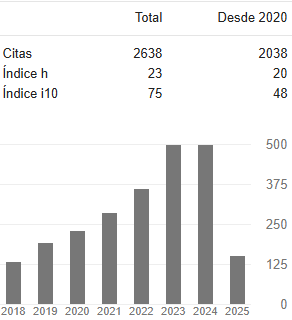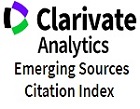Evaluación del Desempeño de los Modelos de Tráfico Modulados por Cadenas de Markov en Redes 802.11 – Caso de Estudio Red QRD
DOI:
https://doi.org/10.31908/19098367.699Palabras clave:
QRD, WLAN, MAC, ranura de tiempo, ventana de contienda, cadenas de Markov, trafico, correlación, prueba de bondad de ajuste, snifferResumen
En este artículo se evalúa el desempeño de los modelos basados en procesos modulados por cadenas de Markov en redes IEEE 802.11. El estudio se centra en la red “Quindio Región Digital” (QRD). La evaluación del desempeño de los modelos de tráfico se desarrolla en tres etapas. En la primera etapa se obtienen las características estadísticas del tráfico real de la red QRD. En la segunda etapa, se realiza una selección de los modelos de tráfico que se adecuan mejor a las características reales de la red QRD tales como operación fuera de saturación y manejo de tráfico heterogéneo. En la tercera etapa, se define una métrica del desempeño, la cual se utiliza para evaluar los patrones de tráfico real y generado con el modelo a través de simulación.
Descargas
Referencias
E. Astaiza H., H. Bermudez O and D. Salgado, “Performance Evaluation of Selfsimilar Models for Traffic on IEEE 802.11 Networks - Stydy of Case for the QRD Network,” ITECKNE, vol. 9, no. 2, pp. 33 - 39, 2012.
Y. Tay and K. Chua, “A Capacity Analysis for the IEEE802.11 MAC Protocol,” Wireless Networks 7, pp. 159-171, 2001.
P802.11, IEEE Standard for Wireless LAN Medium Access Control (MAC) and Physical Layer (PHY) Specifications, 1997.
G. Bianchi, “Performance Analysis of the IEEE 802.111Distributed Coordination Function,” IEEE Journal on SelectedAreas in Communications, vol. Vol. 18, no. No. 3, 2000.
U. Lamping, R. Sharpe and E. Warnicke, Wireshark User’s Guide, Wireshark 1.4, 2004.
E. Astaiza, H. F. Bermúdez and P. A. Gutiérrez, Simulación De Sistemas De Telecomunicaciones, Armenia: Ed Padilla Bejarano , Ferney, 2007.
B. Bellalta, M. Oliver, M. Meo and M. Guerrero, “A Simple Model of the IEEE 802.11 MAC Protocol with Heterogeneous Traffic Flows,” Belgrade, Serbia and Montenegro, 2005.
K. Duffy, D. Malone and D. J. Leith, “Modeling the 802.11 Distributed Coordination Function in Non-Saturated Conditions,” IEEE COMMUNICATIONS LETTERS, vol. 9, no. 8, 2005.
B. I. Villy, TELETRAFFIC ENGINEERING HANDBOOK, Technical university of Denmark, 2001.
J. Hayes F. and T. Ganesh Babu, MODELING AND ANALYSIS OF TELECOMUNICATIONS NETWORKS, New Jersey: John wiley & sons, inc, 2004.
I. S. Oleg, M. S. Sergey and V. O. Andrey, SELF-SIMILAR PROCESSES IN TELECOMMUNICATION, John wiley & sons, ltd, 2007.
G. Xiao-hu, Y. Yang, W. Cheng-Xiang, L. Ying-Zhuang, L. Chuang and X. Lin, Characteristics analysis and modeling of frame traffic in 802.11 wireless networks, John Wiley& Sons, Ltd, 2009.
G. Fiche and G. Hebuterne, “Communicating Systems & Networks: Traffic & Performance,” London and Sterling, VA., 1988.
W. Grote, C. Ávila and A. Molina, “ANÁLISIS DE MÁXIMO DESEMPEÑO PARA WLAN OPERANDOA TASAS FIJAS O ADAPTIVAS USANDO EL ESTÁNDAR IEEE 802.11 a/b/g,” Revista chilena de ingeniería, vol. 15, no. 3, 2007.
D. P. Pezaros, M. Sifalakis and D. Hutchison, “On the Long-Range Dependent Behavior of Unidirectional Packet Delay of Wireless Traffic,” in IEEE Global Telecommunications Conference (IEEE GLOBECOM), Washington, DC., 2007.
A. Reyes L., “MODELADO DE TRÁFICO DECLIENTES WWW,” Universidad de Málaga, Málaga, 2001.
Descargas
Publicado
Número
Sección
Licencia
Derechos de autor 2019 Entre Ciencia e Ingeniería

Esta obra está bajo una licencia internacional Creative Commons Atribución-NoComercial 4.0.



















